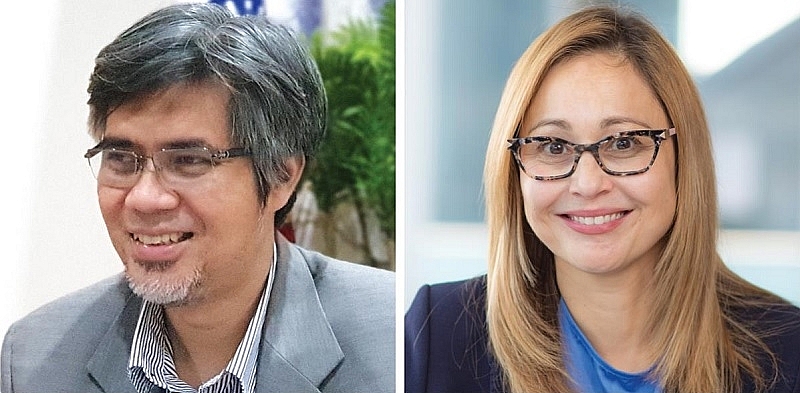Accelerating deployment of clean coal technologies
 |
| Dr. Nuki Agya Utama - executive director of the ASEAN Centre for Energy (left), and Michelle Manook - chief executive of the World Coal Association |
The ASEAN Centre for Energy (ACE) and the World Coal Association (WCA) have signed a three-year deal to strengthen joint commitments to clean coal technologies (CCT). What will the signing mean to the region?
Manook: Coal is a critical enabler to provide affordable, abundant, reliable energy. However, there is a lack of understanding about how that builds communities and how that supports emerging economies, particularly in the ASEAN region.
This collaboration with the ACE is a very good first step for us to really showcase all of the advancements that the ASEAN region is doing in CCT, and also to educate a global audience about the importance of balancing both economic development and environmental issues.
The three years will be a good start with a focus on making sure that there’s good credible data that informs good policy decisions, both with the government, but particularly around investment.
The ASEAN region is showing great leadership, and it’s at the forefront of those high efficiency, low emission technologies. This is a very important step to bridging the gap towards zero emissions.
Utama: The agreement is timely as it will support implementation of the ASEAN Plan of Action for Energy Cooperation (APAEC) Phase II endorsed at the 38th ASEAN Ministers on Energy Meeting. We expect that the MoU will pave the way for ASEAN in achieving key strategies and also facilitating energy transition and enhancing energy resilience.
According to the sixth ASEAN Energy Outlook, Coal is projected to remain central in the ASEAN power mix, which is projected to reach around 36 per cent by 2040.
On the other hand, despite its affordability, using coal as an energy source has made environmental issues due to its growing emission per capita. In 2017, ASEAN emissions per capita were about 2.62 tonnes of CO2 equivalent.
ASEAN is currently aiming for 23 per cent renewables share by 2025, but the thing that needs to be concerned is that achieving those targets will not massively reduce fossil fuel. While the intermittent concern of renewable energy still needs to be resolved in the future, AMS can still move toward energy transition by implementing CCT to reduce greenhouse gas emissions.
In Vietnam, coal is an important resource but with environmental concerns. How can the country secure financial support and promote policies to accelerate the deployment of CCT?
Manook: It seems that investors and their sustainability committees are really not fully knowledgeable of the total contribution of coal, the importance of coal, and limitations of renewables. And many decisions are actually being made by traditional investors that are ill-informed.
I believe that the Vietnamese government understands that dismissing coal, and more importantly, dismissing CCT is actually quite dangerous to the overall long-term sustainability of a robust and affordable energy system, which powers their economic growth.
With the country’s draft national power development plan, it has that consideration for ultra-super critical technologies. This is all important leadership to other global markets in how to create a very clear policy setting for the development of CCT.
Utama: We noted that some ASEAN countries still need coal for sustaining its high level of growth and the environmental pollution from coal is one of the issues that should be addressed.
Countries could ensure the seriousness to implement the technologies to maximise the efficiency and minimise the emission coming from the new coal power plants through the promotion of CCT utilisation, such as by enacting more stringent environmental and efficiency standards or mandating the new coal power plants to only utilise advanced technology.
What global stories can Vietnam learn from in CCT growth and sustainable development, and how can players adapt to the increasingly globalised market?
Utama: Japan since 2012 has proposed a post-Kyoto Protocol emission-reduction credit mechanism. This provides support and incentives to the Japanese private sector to export emission reduction and low carbon technologies to developing countries such as India, Indonesia, and Vietnam.
Through this mechanism, Japan expects to benefit from emission reduction credits, while the countries receiving the technologies will get high-end, efficient technology on competitive terms.
Manook: The Sasan supercritical power plant project in India has the potential to generate power for 17.5 million people across 17 states in that region, and that creates 41,000 jobs throughout its construction and operational life. It also enables 22 million people to have access not just to energy, but to energy that powers a safe water supply.
To adapt to globalisation, it’s very important that government policy is quite clear that it includes coal and CCT, and it incentivises for development. So the clarity really must come from government policy initially, but investment policies should support that policy.
What the stars mean:
★ Poor ★ ★ Promising ★★★ Good ★★★★ Very good ★★★★★ Exceptional
Related Contents
Latest News
More News
- Vietnam’s forest carbon credits draw global interest (December 05, 2025 | 17:41)
- Coro Energy to launch BESS Pilot in Vietnam (December 04, 2025 | 15:12)
- Vietnam strengthens energy storage pathway (December 04, 2025 | 15:05)
- Women take leading role in agriculture and food systems (December 03, 2025 | 19:04)
- Experts highlight unpaid care work as key barrier to gender equality (December 03, 2025 | 15:15)
- Vietnam sets pace for dual transition in industry and trade (December 03, 2025 | 14:12)
- Harnessing technology for a sustainable future in Vietnam (December 03, 2025 | 12:17)
- Sustainability efforts on right track through policy and tech (December 03, 2025 | 12:05)
- Hanoi symposium highlights gender equality research and policy (December 03, 2025 | 12:00)
- The march to productivity and environmental sustainability (December 03, 2025 | 09:17)

 Tag:
Tag:

















 Mobile Version
Mobile Version